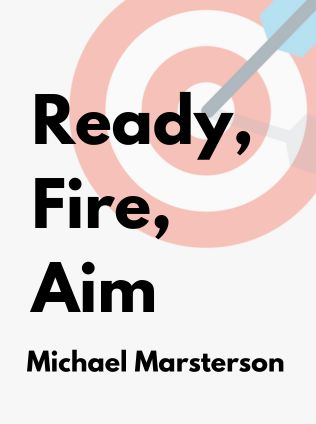
Ready, Fire, Aim
Zero to $100 Million in No Time Flat
By Michael Marsterson
Published 01/2008
About the Author
Michael Masterson is a successful entrepreneur, author, and business consultant with decades of experience in building and growing companies. Known for his practical and actionable advice, Masterson has written several bestsellers on business and personal development. His book "Ready, Fire, Aim: Zero to $100 Million in No Time Flat" provides a comprehensive guide to the stages of business growth and the skills needed to navigate each stage successfully.
Main Idea
"Ready, Fire, Aim" explores the essential stages of business growth and the unique challenges and opportunities each stage presents. Masterson argues that to succeed, entrepreneurs must understand and master the different phases of business development: Infancy, Fast-Growth, Adolescence, and Maturity. Each stage requires distinct strategies and skills to overcome challenges and capitalize on opportunities, ensuring sustained growth and profitability.
"Businesses don’t grow big and become profitable by accident. There are reasons why the great ones succeed." – Michael Masterson
Table of Contents
- Infancy – From Zero to $1 Million
- Fast-Growth – From $1 Million to $10 Million
- Adolescence – From $10 Million to $50 Million
- Maturity – $50 Million and Beyond
Infancy – From Zero to $1 Million
During the infancy stage, the primary focus is on taking your business from an idea to a sustainable entity generating cash. The main problem is that you don’t know what you’re doing, and the key challenge is making your first profitable sale.
"Until your new business makes its first sale, it’s really nothing more than an unproven idea you’re spending money on." – Michael Masterson
To navigate this stage successfully, focus on selling above all else. Your key priorities should be getting your first product ready to sell, making that first sale, and then improving the product based on customer feedback. Don't worry about fancy logos, glossy brochures, or leasing office space—those can come later.
- Get Your Product Ready: Ensure your product is good enough to sell, even if it’s not perfect.
- Make the First Sale: Focus on getting out into the marketplace and making your first sale.
- Improve and Iterate: Once you start selling, work on improving the product based on feedback.
Optimal Selling Strategy (OSS)
Determining your OSS involves finding the best way your startup can acquire new customers. This requires answering four critical questions:
Sign up for FREE and get access to 1,400+ books summaries.
You May Also Like
The Lean Startup
How Today's Entrepreneurs Use Continuous Innovation to Create Radically Successful Businesses
By Eric RiesWho Moved My Cheese?
An Amazing Way to Deal with Change in Your Work and in Your Life
By Spencer Johnson, M.D.Make Your Bed
Little Things That Can Change Your Life...And Maybe the World
By William H. McRavenThe Ride of a Lifetime
Lessons Learned from 15 Years as CEO of the Walt Disney Company
By Robert Iger



















